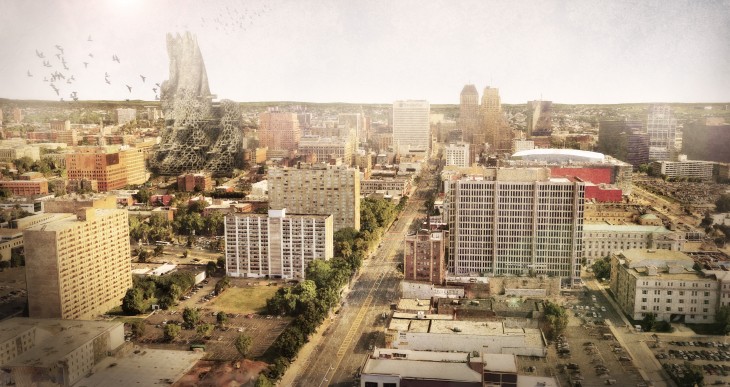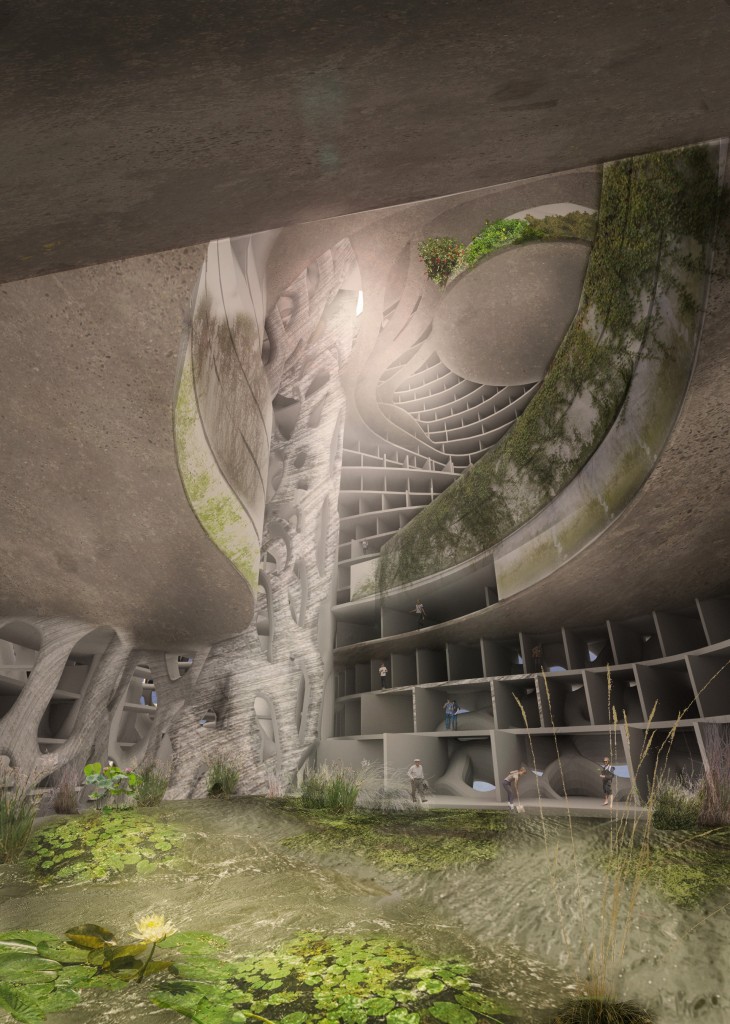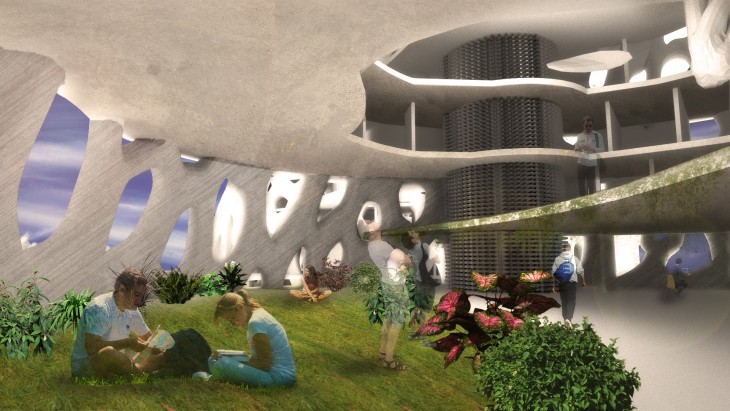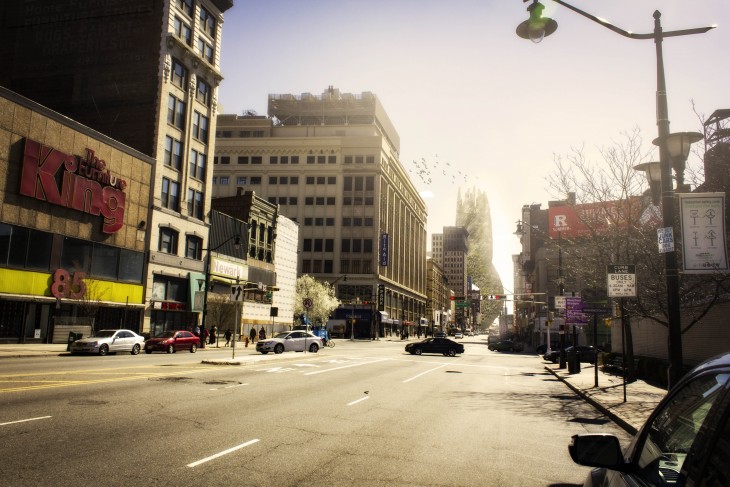
Cybeco is the proposal for the prototype and conception point of a cybernetic approach to renaturalize the city. The project will act as a mothership and platform for the inhabitants of newark to reestablish flora and fauna within the city. It will act as a educational facility solely dedicated on experimentation of performative species, a seed bank/repository for inhabitants to trade and plant new plants around the city and an infrastructure that enhances the anemophillic {pollination by wind} function of the natural ecology.
Global scale of the urbanisation will place 70% of the world’s population in cities – the speculation of 7000 million people in the year 2050. City and nature can no longer be viewed as two separate entities – It is imperative to establish a network of symbiotic relationships between the functional needs of the urban population with the performative aspects of nature. Current paradigms show that the growth of cities is directly attributed to the loss or destruction of the natural environment it lives on.
Cities invest large amount of resources to exchange vital goods and resources such as air, water and energy in an incredibly inefficient manner, which causes a constant degradation in the quality of life of the urban population, through a series of contemporary issues such as degrading air quality, water quality and etc.
In order to exemplify our assumption we conducted a series of studies and analyses of major cities within the U.S. By using LANDSAT satellite imagery, we were able to assess the health of the vegetation within a certain zone of the city, through a direct comparison and calculation of the red channel and the infrared channel of the image. The operation was completed via the NERO plugin for grasshopper. In this sense we are able to continously monitor the health of the vegetation/flora within urban cities.
As a starting point, it was necessary to take a standpoint on the definition or scope of nature itself, reduced to the mere question “what will be role of nature in future cities?”
![[20160620]_RSI_R5_Hybritat & cybeco_Finals_Page_12](https://www.iaacblog.com/wp-content/uploads/2016/06/20160620_rsi_r5_hybritat-cybeco_finals_page_12-730x516.jpg)
In the first semester, the team focused on the methodology and importance of strategies to re-implement nature within the city. To provide a fresh perspective on the object, it was necessary to start to analyse the current civic situation within the city itself. What is happening in the urban context of the city?
![[20160620]_RSI_R5_Hybritat & cybeco_Finals_Page_14](https://www.iaacblog.com/wp-content/uploads/2016/06/20160620_rsi_r5_hybritat-cybeco_finals_page_14-730x516.jpg)
The city seems to be under going a process of revitalisation, demonstrated through the formulation and updating of masterplans and zoning plans for the city. Through careful analysis of the city’s trends and behaviour, a speculation was made to obtain the essence for change. The conglomeration of a university “village” for the city could mean that the city wants to use education as a major driver for the revitalisation of the city. To test this theory, mappings of the educational facilities around the city were conducted to see if there are clusters or patterns that can be deduced.
![[20160620]_RSI_R5_Hybritat & cybeco_Finals_Page_16](https://www.iaacblog.com/wp-content/uploads/2016/06/20160620_rsi_r5_hybritat-cybeco_finals_page_16-730x516.jpg)
![[20160620]_RSI_R5_Hybritat & cybeco_Finals_Page_17](https://www.iaacblog.com/wp-content/uploads/2016/06/20160620_rsi_r5_hybritat-cybeco_finals_page_17-730x516.jpg)
HYPOTHESIS – In order to achieve this resynchronisation and rebalancing of city and nature – we need to rethink how we manage our ecology and ecosystem – the relationship between organisms to each other as well as our physical surroundings – start to incorporate cybernetics into the urban ecology. The city can no longer be viewed as 2 separate entities – but rather we need to start to establish a series of symbiotic relationships – whereby the enhancements in the quality of life of the urban population is directly attributed through the cybernetic approach of improving the performative aspects of the natural environment.
![[20160620]_RSI_R5_Hybritat & cybeco_Finals_Page_18](https://www.iaacblog.com/wp-content/uploads/2016/06/20160620_rsi_r5_hybritat-cybeco_finals_page_18-730x516.jpg)
Tools have already been developed to make this strategy and process a reality. All exchanges, representation and physical manifestation of matter can now be digitised and parameterized to make complex calculations a possible. This data can then be used as inputs for complex algorithms to deduce urban phenomenas.
![[20160620]_RSI_R5_Hybritat & cybeco_Finals_Page_19](https://www.iaacblog.com/wp-content/uploads/2016/06/20160620_rsi_r5_hybritat-cybeco_finals_page_19-730x516.jpg)
![[20160620]_RSI_R5_Hybritat & cybeco_Finals_Page_20](https://www.iaacblog.com/wp-content/uploads/2016/06/20160620_rsi_r5_hybritat-cybeco_finals_page_20-730x516.jpg)
Through this approach, the proposal should then tackle the initial questions and issues prosed in the beginning of the research. The workflow above shows the different aspects of the proposal that requires resolution. It is the successful interweaving of these aspects that will enable the full functionality of the proposal.
In order to nature to contribute with a greater force within the city, it was necessary to research the performative aspects of nature. This was taken one step further by categorising native and invasive species according to the 5 major functions deduced in the workflow – water management, energy management, atmospheric management, geologic management and food production.
![[20160620]_RSI_R5_Hybritat & cybeco_Finals_Page_21](https://www.iaacblog.com/wp-content/uploads/2016/06/20160620_rsi_r5_hybritat-cybeco_finals_page_21-730x516.jpg)
![[20160620]_RSI_R5_Hybritat & cybeco_Finals_Page_23](https://www.iaacblog.com/wp-content/uploads/2016/06/20160620_rsi_r5_hybritat-cybeco_finals_page_23-730x516.jpg)
![[20160620]_RSI_R5_Hybritat & cybeco_Finals_Page_24](https://www.iaacblog.com/wp-content/uploads/2016/06/20160620_rsi_r5_hybritat-cybeco_finals_page_24-730x516.jpg)
![[20160620]_RSI_R5_Hybritat & cybeco_Finals_Page_25](https://www.iaacblog.com/wp-content/uploads/2016/06/20160620_rsi_r5_hybritat-cybeco_finals_page_25-730x516.jpg)
![[20160620]_RSI_R5_Hybritat & cybeco_Finals_Page_26](https://www.iaacblog.com/wp-content/uploads/2016/06/20160620_rsi_r5_hybritat-cybeco_finals_page_26-730x516.jpg)
![[20160620]_RSI_R5_Hybritat & cybeco_Finals_Page_27](https://www.iaacblog.com/wp-content/uploads/2016/06/20160620_rsi_r5_hybritat-cybeco_finals_page_27-730x516.jpg)
The final project outcome will be the harmonious implementation of different modules of performative nature throughout the city, whether it is through a centralised system or a distributed network. – in a way that it creates a terrarium of a cybernetic ecology.
![[20160620]_RSI_R5_Hybritat & cybeco_Finals_Page_29](https://www.iaacblog.com/wp-content/uploads/2016/06/20160620_rsi_r5_hybritat-cybeco_finals_page_29-730x516.jpg)
In order to reduce the scope of the project to a more feasible manner , more specifically, to have a physical manifestation of a block scale, the proposal will focus on the conception point of the citywide system.
![[20160620]_RSI_R5_Hybritat & cybeco_Finals_Page_30](https://www.iaacblog.com/wp-content/uploads/2016/06/20160620_rsi_r5_hybritat-cybeco_finals_page_30-730x516.jpg)
Pollination by wind – Anemophily was the major form finding element for the global shape of the intevention. A series of pollen simulations were conducted to obtain the optimum form to ensure that the building becomes in itself a pollinator of multiple species within the city.
initial particles
incorporation of wind conditions within the site.
selection of containment region.
Height and Cover Reach Simulations
SIMULATION PARAMETERS
density of pollen = 0.3g/cm3
volume = 4/3(pi r3)
average radius of pollen = 50 micrometer
density = (m)ass/(v)olume
m = Dv
= 0.3g x (1.05 x 10-8)
MASS OF POLLEN
1.57079633 e-16 KG
Iteration 1 – 100% height
Iteration 2 – 80% Height
Iteration 3 – 50% Height
Once the form was deduced, the programmatic requirements were explored to see which iteration could best host the requirements of a new educational model, where by the students learn by living within the environment that they are studying. Precedent study of similar institutions around the world were conducted to deduce a genecode, to replicate within the new model.
![[20160620]_RSI_R5_Hybritat & cybeco_Finals_Page_36](https://www.iaacblog.com/wp-content/uploads/2016/06/20160620_rsi_r5_hybritat-cybeco_finals_page_36-730x516.jpg)
![[20160620]_RSI_R5_Hybritat & cybeco_Finals_Page_39](https://www.iaacblog.com/wp-content/uploads/2016/06/20160620_rsi_r5_hybritat-cybeco_finals_page_39-730x516.jpg)
![[20160620]_RSI_R5_Hybritat & cybeco_Finals_Page_41](https://www.iaacblog.com/wp-content/uploads/2016/06/20160620_rsi_r5_hybritat-cybeco_finals_page_41-730x516.jpg)

Central Atrium

Seed Repository Interface

Streetview
“All Watched Over by Machines of
Loving Grace”
by Richard Brautigan
I’d like to think
of a cybernetic meadow
where mammals and computers
live together in mutually
programming harmony
like pure water
touching clear sky.
I like to think
of a cybernetic forest
filled with pines and electronics
where deer stroll peacefully
past computers
as if they were flowers
with spinning blossoms.
I like to think
of a cybernetic ecology
where we are free of our labors
and joined back to nature,
returned to our mammal brothers and sisters,
and all watched over
Cybeco is a project of IaaC, Institute for Advanced Architecture of Catalonia
developed at Master in Advanced Architecture in 2016 by:
Students:
Jonathan Irawan
Faculty:
Willy Müller,
Jordi Vivaldi Piera
Starsk Lara